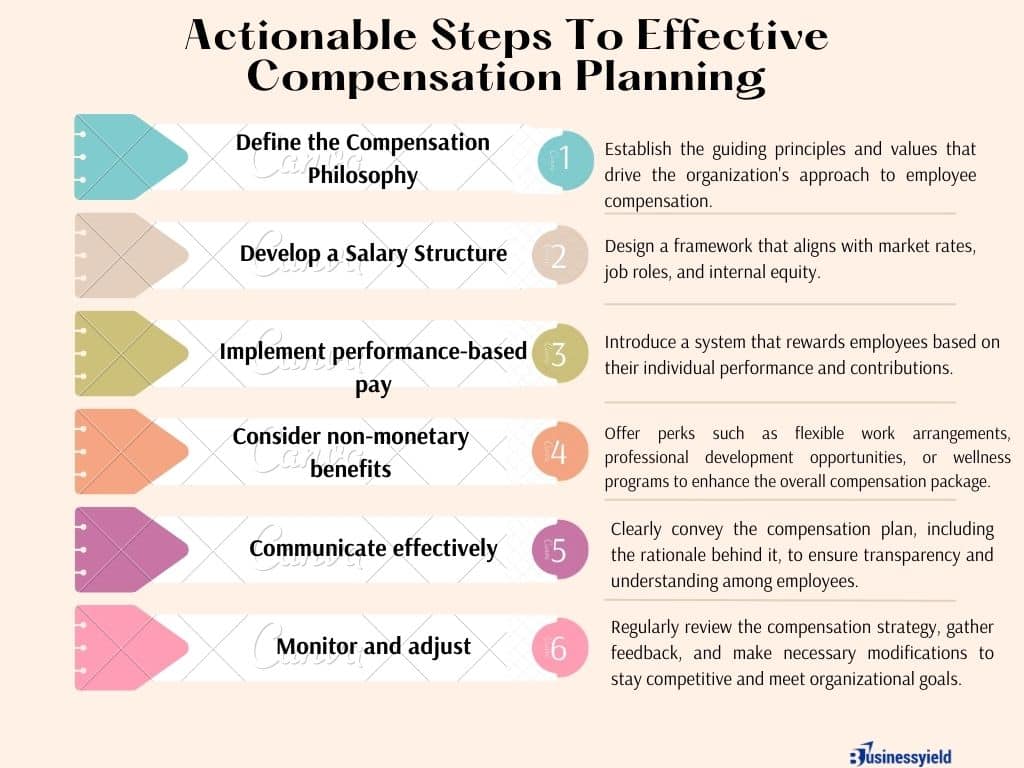Let me take you on a journey towards mastering the art of effective compensation planning. As someone who has much experience, I understand the critical role that compensation plays in attracting, retaining, and motivating employees. However, navigating compensation planning can often seem like a daunting task. That’s why I am excited to share with you a simple guide and actionable steps to effective compensation planning, including the tool(s) to benefit sales for your organization. So, get ready to unlock the secrets to successful compensation planning and propel your organization to new heights!
Key Points
- Effective compensation planning starts with aligning the compensation strategy with the overall strategic goals and objectives of the organization.
- Relevant data on market trends, industry standards, and employee expectations ensure competitive and fair compensation packages.
- Clear and transparent communication about the compensation structure, performance expectations, and opportunities for advancement is vital for maintaining employee satisfaction and engagement.
- Open communication with employees about the compensation philosophy and individual performance impacts salary decisions.
- Retaining top talent and promoting a positive company culture requires regular evaluations of the effectiveness of compensation plans and making adjustments as needed.
A Simple Guide And Actionable Steps To Effective Compensation Planning
When it comes to effective compensation planning, many organizations struggle to find the right balance between attracting, motivating, and retaining top talent while managing costs. I understand how frustrating it can be, but I have some sure steps that will help you.
By following a simple guide and actionable steps, you can create a strategic compensation plan that aligns with your business goals and values.
First and foremost, conduct a thorough analysis of your organization’s current compensation structure and practices. This includes evaluating market data, benchmarking against competitors, and understanding the needs and expectations of employees. By gaining a clear understanding of where your company stands in terms of compensation, you can identify areas for improvement and develop a targeted plan.
Next, set clear objectives for the compensation plan. Whether the goal is to attract top talent, improve retention rates, or align compensation with performance, having specific objectives in place will guide the development and implementation of your plan.
Once you’ve established these objectives, then you can some steps for effective compensation planning. Hence, I have the following steps for you to create an effective compensation plan:
#1: Define the Compensation Philosophy
A compensation philosophy is a set of guiding principles that outline how an organization values its employees through compensation and benefits. To effectively define a compensation philosophy, I recommend the following actionable steps:
- First, conduct a thorough analysis of your organization’s values, goals, and culture. This will help you align the compensation philosophy with its overall mission and objectives.
- Then, consider market data and industry benchmarks to ensure the philosophy is competitive and reflects external market trends.
- Lastly, involve key stakeholders. There’s a saying that goes, “Two heads are better than one”, so I advise you to include HR, finance, and senior leadership. They’ll help you develop and finalize the compensation philosophy to gain buy-in and alignment across the organization.
For instance, in a company I worked with, we developed a compensation philosophy that emphasized pay for performance, career development, and internal equity. By clearly communicating this philosophy to employees, we saw improved morale and increased motivation among staff members.
#2: Develop a Salary Structure
A salary structure is a framework that outlines the pay range for different roles within an organization based on factors like job responsibilities, experience, and performance. To develop a salary structure effectively, I recommend the following steps:
- Conduct a comprehensive job analysis. This will help you to understand the skills, responsibilities, and requirements of each role within the organization.
- After that, use market data and salary surveys to benchmark salaries for different job levels. Also, ensure that the structure is competitive and aligned with industry standards.
- Establish clear salary ranges and guidelines for salary increases and promotions to promote transparency and equity across the organization.
In a previous project, we developed a salary structure that incorporated competitive market data and internal job evaluations. This helped the organization attract top talent, reduce turnover, and maintain a fair and consistent approach to compensation management.
#3. Implement performance-based pay
As an expert in compensation planning, I have found that implementing performance-based pay is a crucial step. It ensures that employees are motivated and rewarded for their hard work. This approach ties an employee’s compensation directly to their performance, thus incentivizing them to strive for higher levels of productivity and excellence. When you set clear and measurable performance targets, I am certain your employees will be motivated to meet and surpass these goals to earn higher pay.
One example of implementing performance-based pay is through a sales commission structure. In this setup, sales professionals receive a percentage of the revenue they generate, thus linking their compensation directly to their performance in driving sales. I don’t think your workers would miss out on this opportunity. This not only incentivizes your employees to work harder to increase sales numbers but also rewards them for their efforts.
#4. Consider non-monetary benefits
Furthermore, considering non-monetary benefits is another important aspect of effective compensation planning. While monetary compensation is vital, non-monetary benefits can also play a significant role in attracting and retaining top talent. This includes flexible work hours, remote work options, professional development opportunities, and healthcare benefits. Their benefits can enhance the overall employee experience and contribute to a positive workplace culture.
For instance, offering flexible work hours can help your employees achieve a better work-life balance, leading to increased job satisfaction and productivity. If you provide professional development opportunities such as training programs or tuition reimbursement can help them grow in their careers and feel valued. Additionally, healthcare benefits can contribute to employees’ overall well-being and serve as an important retention tool.
#5. Communicate effectively
To effectively communicate in compensation planning, and ensure clarity and transparency throughout the process involves clearly defining the compensation philosophy, structures, and any changes being implemented. Also, regularly engaging with employees to understand their needs and preferences is essential.
You might be wondering how you can achieve this, don’t worry, I’ll guide you. For instance, conducting surveys or focus groups can give you valuable insights. That’s to say, what motivates your employees and helps in designing effective compensation packages.
#6. Monitor and adjust
Monitoring and adjusting compensation plans is necessary to ensure they stay relevant and competitive. This involves regularly reviewing market trends, analyzing employee performance, and assessing the impact of the existing compensation strategies.
Moreover, if you stay informed about market conditions and industry standards, you can make timely adjustments to your compensation plans to attract and retain top talent. For example, conducting annual salary benchmarking studies and performance reviews can help identify areas for improvement and inform adjustments to compensation structures. Read this article MARKET ANALYSIS: What It Is and Complete Guide on How to Conduct It
In my experience, I have found that by implementing these actionable steps of effective compensation planning, you can create a fair and competitive compensation framework that aligns with your business objectives and meets the needs of your employees. This proactive approach not only helps in retaining top talent but also boosts employee morale and productivity.

Sales Compensation Planning
Sales compensation planning is typically something that companies focus on at specific times of the year. It is a critical aspect of any sales organization as it directly impacts the motivation and performance of sales teams. In my experience, I have found that sales compensation planning usually takes place at the beginning of a new fiscal year or before the launch of a new sales initiative.
I have been involved in the sales compensation planning process multiple times. It involves assessing the goals and targets for the upcoming period, analyzing the market conditions, and designing a compensation structure. These helped me to align with the company’s objectives while also motivating the sales team to achieve the targets.
During the planning phase, I collaborate with the finance and HR teams to ensure that the compensation plans are fair, competitive, and achievable. In essence, this process often requires a delicate balance between providing incentives for high performance and maintaining the company’s budget constraints.
Meanwhile, I recommend this article for you COMPENSATION PLANS FOR SALES: Best Options for Reps, Managers & Executives
Compensation Planning Tool
We are now in the 21st century where almost everything has been modernized to make our work easier and faster. Compensation planning tool is no exception to this trend, as companies now have access to sophisticated tools and software that streamline the process of designing and managing employee compensation packages.
In other words, a compensation planning tool is a crucial tool for organizations to manage their employee compensation effectively. It helps in ensuring fair and competitive pay practices, aligning with the company’s goals and budget.
One popular compensation planning tool is “Payscale.” I have had the opportunity to utilize Payscale. This tool enabled me to easily compare compensation data across different job roles, benchmark salaries against industry standards, and create customized salary structures based on performance metrics. Overall, I must say that the compensation planning tool is a valuable asset in ensuring equitable and competitive pay practices within the organization. To know more, here’s an article for you Best 15 Compensation Management Software In 2023
What Are The Steps Involved In Developing A Compensation Plan?
I cannot stress enough how many stages are involved in creating a compensation plan. I implore you to write these down because they are highly significant. Thus, these are the top 5 crucial procedures in creating a compensation plan.
- Job Analysis
- Market Research
- Establish Compensation
- Perform Evaluation
- Communication and Review
As I stated earlier, developing a compensation plan is a complex process that requires thoughtful consideration and attention to detail. So, with the above steps, you can create a compensation plan that not only motivates employees but also aligns with the organization’s overall strategy for success.
Compensation Benefit Planning
What if I tell you that there are some companies where employees are not satisfied with their salaries and benefits? There is a lack of motivation and productivity is declining. I guess you wouldn’t want that for your workers.
Compensation benefit planning is a crucial aspect of human resource management. It involves designing and implementing strategies to attract, retain, and motivate employees through a comprehensive package of rewards and benefits. By integrating various elements such as base salary, bonuses, health insurance, retirement plans, and other perks, you can create a competitive compensation package that aligns with your business goals and values.
Effective compensation benefit planning not only helps in attracting top talent but also plays a significant role in employee satisfaction and engagement. So, you should conduct thorough research and analysis to understand market trends, industry standards, and employee preferences to design a tailor-made compensation package that meets the needs of both the employees and the organization.
Furthermore, a well-thought-out compensation benefit plan can enhance employee loyalty, productivity, and overall organizational performance. It is a continuous process that requires regular reviews and adjustments to ensure that the compensation package remains competitive and aligned with the evolving needs of the workforce and the business environment.
What Are The Objectives Of Compensation Planning?
Imagine working hard at your job, putting in extra hours, taking on additional responsibilities, and consistently exceeding expectations. Now, picture receiving recognition and rewards for your dedication and performance. How would that make you feel? Valued, motivated, and more committed to achieving your goals, right?
Now, let me explain the objectives of compensation planning. Compensation planning aims to attract and retain top talent by offering competitive salaries and benefits. It also seeks to motivate employees to perform at their best, rewarding them for their efforts and achievements. Additionally, compensation planning helps ensure internal equity within the organization, where employees are fairly compensated based on their roles and responsibilities.
Moreover, effective compensation planning can enhance employee satisfaction and engagement, leading to higher levels of productivity and overall organizational success. So, when you align compensation with your company’s goals and values, it will foster a culture of performance and recognition. That’s driving employees to excel and contribute to the company’s growth.
What Must Be Any Compensation Plan?
I believe that a good compensation plan should include base salary, bonuses, and benefits to properly reward employees for their hard work and dedication. For instance, a sales team can have a compensation plan that includes a base salary along with a commission for meeting or exceeding sales targets. This motivates the team to perform at their best to earn more through their efforts.
Additionally, benefits such as healthcare coverage, retirement plans, and paid time off are essential parts of a comprehensive compensation package. Moreover, these benefits not only show employees that their well-being is valued but also help to create a positive work environment and boost morale.
What Is The Most Common Compensation Plan?
The most common compensation plan used by many companies is the salary-based compensation plan. This type of plan provides employees with a fixed amount of money at regular intervals. It’s typically on a monthly or bi-weekly basis, regardless of their performance or productivity levels.
Additionally, it offers stability and predictability for employees, as they know exactly how much they will earn each pay period. Hence, this can be particularly beneficial for employees who value financial security and have fixed expenses to manage.
How To Structure A Salary-based Compensation Plan
Final Thoughts
Effective compensation planning is crucial for the success and sustainability of any organization. By following the simple guide and actionable steps provided, you can ensure your compensation strategy aligns with your business goals and values, while also motivating and retaining top talent.
As I have highlighted throughout this article, taking a strategic and data-driven approach to compensation planning can lead to improved employee engagement, productivity, and overall organizational performance. Now, you see why you should continuously evaluate and adjust your compensation plans to stay competitive in the job market. Also, implementing these strategies can set the foundation for a strong and successful workforce, ultimately driving your company toward greater success.
Compensation Plan: Best United States Practices (Updated)
THE ROLE OF OTE COMPENSATION IN MOTIVATING TEAMS
COMPANY RETIREMENT PLANS: Detailed Guide to Choosing a Suitable Plan






